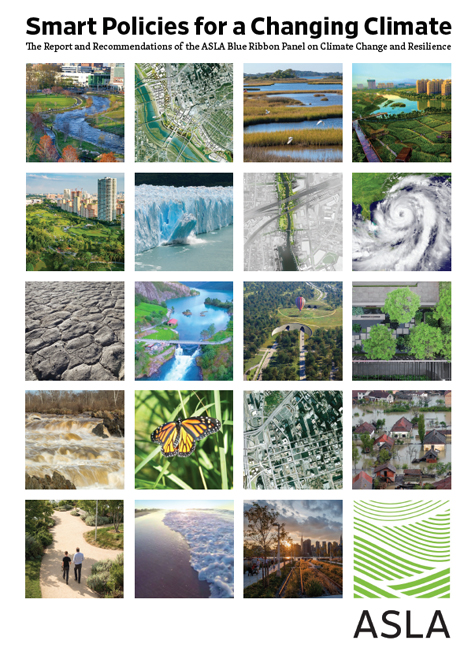Professional Practice
Climate Change Mitigation: Natural Systems
Download Report:
According the United Nations, the world’s forests store approximately 296 billion tons of carbon in their biomass and soils. When forests are cleared, degraded, or disturbed, that carbon is released into the atmosphere. By some estimates, deforestation around the world is responsible for as much as 15 percent of global greenhouse gas (GHG) emissions.
Other natural landscapes also capture and store carbon dioxide. Peatlands – boggy wetland areas rich in decomposing plant matter – cover 3 percent of the world’s surface, but store twice as much carbon as the earth’s forests. The world’s oceans sequester 2.4 to 4.6 percent of annual carbon emissions, at least half of which is stored in coastal wetlands. And according to research by the World Resources Institute, grasslands are responsible for approximately 34 percent of global terrestrial carbon storage.
Landscape architects are protectors of these vital landscapes. They work with government agencies, planners, and developers to limit sprawl and prevent emissions from development. They work with non-profits and private landowners to restore degraded landscapes and create forests where there were none before, undoing the effects of harmful land management practices and adding acreage back to the world’s carbon sink.
Creating access is key to preserving these natural landscapes. A survey conducted by The Nature Conservancy found that teenagers with personal experiences in nature were significantly more likely than their peers to be concerned about environmental issues. However, that same survey found that lack of access to natural areas prevents teenagers from spending more time outdoors.
Landscape architects design low-impact, sustainable park facilities, visitor centers, and trails that allow visitors to experience and appreciate natural landscapes. They work with parks departments at all levels of government to create master plans, interpretive and educational signage, and wayfinding.
Conserving land can also bring economic benefit. Landowners can sell carbon credits on carbon offset registries and markets to draw a profit from their conservation practices. Carbon trading can provide valuable economic support for rural areas, while cities can sell their offsets to fund parks and other forms of urban nature.
Expanding the preservation of natural systems only helps communities better adapt to climate change and become more resilient. And maintaining biodiversityin natural systems is critical to their survival, as diversity is central to system resilience and function.
Organizations
The Blue Carbon Initiative
Center for International Forestry Research
Natural Areas Conservancy
Open Space Institute
United Nations Forum on Forests
United Nations Collaborative Programme on Reducing Emissions from Deforestation and Forest Degredation in Developing Countries (UN-REDD)
Resources
Can Planting Trees Help Us Avoid Climate Disaster?, Will Hackman, Georgetown Public Policy Review, July 9, 2018
How Small Forests Can Help Save the Planet, The New York Times, September 26, 2016
Natural Climate Solutions, The Nature Conservancy
New Mariposa Grove Protects Fragile Giant Sequoia Ecosystem, The Dirt blog, July 23, 2018
Restored Forests Breathe Life Into Efforts Against Climate Change, The New York Times, December 23, 2014
What is Blue Carbon?, National Oceanic and Atmospheric Administration
Research
Can Meadows Rescue the Planet from CO2?, Jane Braxton Little, Scientific American, May 11, 2017
Grasslands May Be More Reliable Carbon Sinks than Forests in California, Pawlok Dass, Benjamin Z Houlton, Yingping Wang, David Warlind, Environmental Research Letters, 2018
Investigating Afforestation and Bioenergy CSS as Climate Change Mitigation Strategies, Florian Humpenöder et al, Environmental Research Letters, June 2014
The Economic Value of Grassland Species for Carbon Storage, Hungate et al, Science Advances, April 5, 2017
Projects
Eco-Corridor Resurrects Former Brownfield, Ningbo, China
SWA Group
Framing Terrain and Water: Quzhou Luming Park, Quzhou City, Zhejiang Province, China
Turenscape
Grand Teton National Park Craig Thomas Discovery and Visitor Center, Moose, WY
Swift Company, LLC
Laurance S. Rockfeller Preserve, Grand Teton National Park, WY
Hershberger Design
The Metro-Forest Project, Prawet, Bangkok, Thailand
Landscape Architects of Bangkok (LAB)
Orongo Station Conservation Master Plan, Poverty Bay, North Island, New Zealand
Nelson Byrd Woltz Landscape Architects
The Restoring of a Montane Landscape, Rocky Mountains, CO
Design Workshop, Inc.